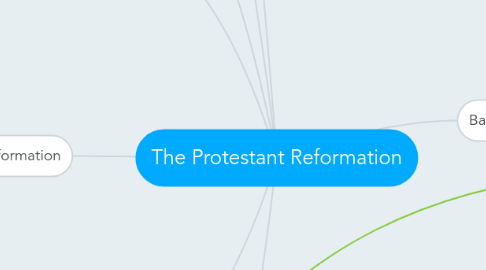
1. Martin Luther: Catalyst of Change
1.1. Young Life
1.1.1. prayed and fasted, trying hard to be a Christian
1.1.2. Became disillusioned by corruption of church
1.2. Wittenberg
1.2.1. Priest Johann Tetzel
1.2.1.1. Offered indulgences to anyone who contributed money to rebuilding of Cathedral of St. Peter
1.2.1.1.1. Last straw for Martin Luther
1.3. 95 Theses against indulgences
1.3.1. arguments
1.3.1.1. had no basis in the Bible
1.3.1.2. Pope had no authority
1.3.1.3. Christians could be saved only through faith
1.3.2. Posted list on door of Wittenberg's All Saints Church
1.3.3. Almost overnight traveled all across Europe
1.4. Aftermath
1.4.1. Charles V called him to diet
1.4.1.1. Diet-"Day for a meeting"
1.4.1.2. Told him to give up beliefs
1.4.1.2.1. He didn't, causing him to become an outlaw
1.5. Beliefs
1.5.1. Salvation achieved through faith
1.5.2. Rituals can't erase sin
1.5.3. Run by elected councils
1.5.4. Bible alone is source of truth
1.5.5. People read and interpret the Bible for themselves
2. Beginnings of Revolt
2.1. Peasants' Revolt
2.1.1. 1524
2.1.2. Called for end to serfdom
2.1.3. Denounced by Luther
2.1.4. Violent
2.2. Peace of Augsburg
2.2.1. Signed in 1555
2.2.2. Allowed each Prince to decide religion
2.2.2.1. Lutheran or Catholic
3. Switzerland's Reformation
3.1. Ulrich Zwingli
3.1.1. rejected elaborate church rituals
3.1.2. stressed importance of Bible
3.2. John Calvin
3.2.1. Shared many of Luther's beliefs
3.2.2. Preached predestination
3.2.2.1. God long ago decided who would reach salvation
3.2.3. Protestants in Geneva wanted to kick him out
3.2.4. Set up strict theocracy in Genvea
4. Protestant Sects
4.1. small separate religious groups
4.1.1. Anabaptists
4.1.1.1. rejected infant baptism
4.1.1.2. some wanted to abolish private property
4.1.1.3. Most were very peaceful
4.1.1.4. Today's Baptists, Mennonites and Amish from Anabaptists
5. English Reformation
5.1. Henry VIII
5.1.1. stood firmly against Protestants at first
5.1.2. Didn't have male heir with first wife
5.1.2.1. Wanted to divorce but pope refused
5.1.2.1.1. Started new Church of England
6. Catholic Reformation
6.1. reform within Church
6.1.1. led by Pope Paul III
6.1.1.1. Called Council of Trent
6.1.1.1.1. decided the Bible is not the only soruce
6.1.1.1.2. took steps to end abuses in church
6.1.1.2. Inquistition
6.1.1.2.1. Church court set up during Middle Ages
6.1.1.2.2. used torture and execution to root out heresy
6.1.1.2.3. Index of Forbidden Books
6.1.1.3. recognized Jesuits in 1540
6.1.1.3.1. Jesuits
6.1.2. Renewed feelings
6.1.2.1. Teresa of Avila
7. Widespread Persecution
7.1. Witch Hunts
7.1.1. 1450-1750
7.1.2. People accused others, usually women, of being witches
7.1.3. Executed brutally
7.1.4. Because of twin beliefs in magic and Christianity
7.1.4.1. Witches believed to be serving the devil
7.2. Persecuting Jews
7.2.1. 1516
7.2.1.1. Venice ordered Jews to live in ghettos
7.2.2. Luther called for them to be expelled from Christian lands
7.2.3. 1550's
7.2.3.1. Pope Paul IV placed restrictions on Jews
7.2.4. Caused them to migrate to Ottoman Empire/Netherlands
8. Background
8.1. Humanist ideas
8.2. Church abuses power
8.2.1. increased fees for marriages and baptisms
8.2.2. Sold indulgences, or lessening of time spent in purgatory
8.2.3. Revolts against church
8.2.3.1. John Wycliffe
8.2.3.1.1. launched attacks against church using sermons and writings
8.2.3.2. Jan Hus
8.2.3.2.1. led a reform movement
8.2.3.2.2. executed for rebellion
